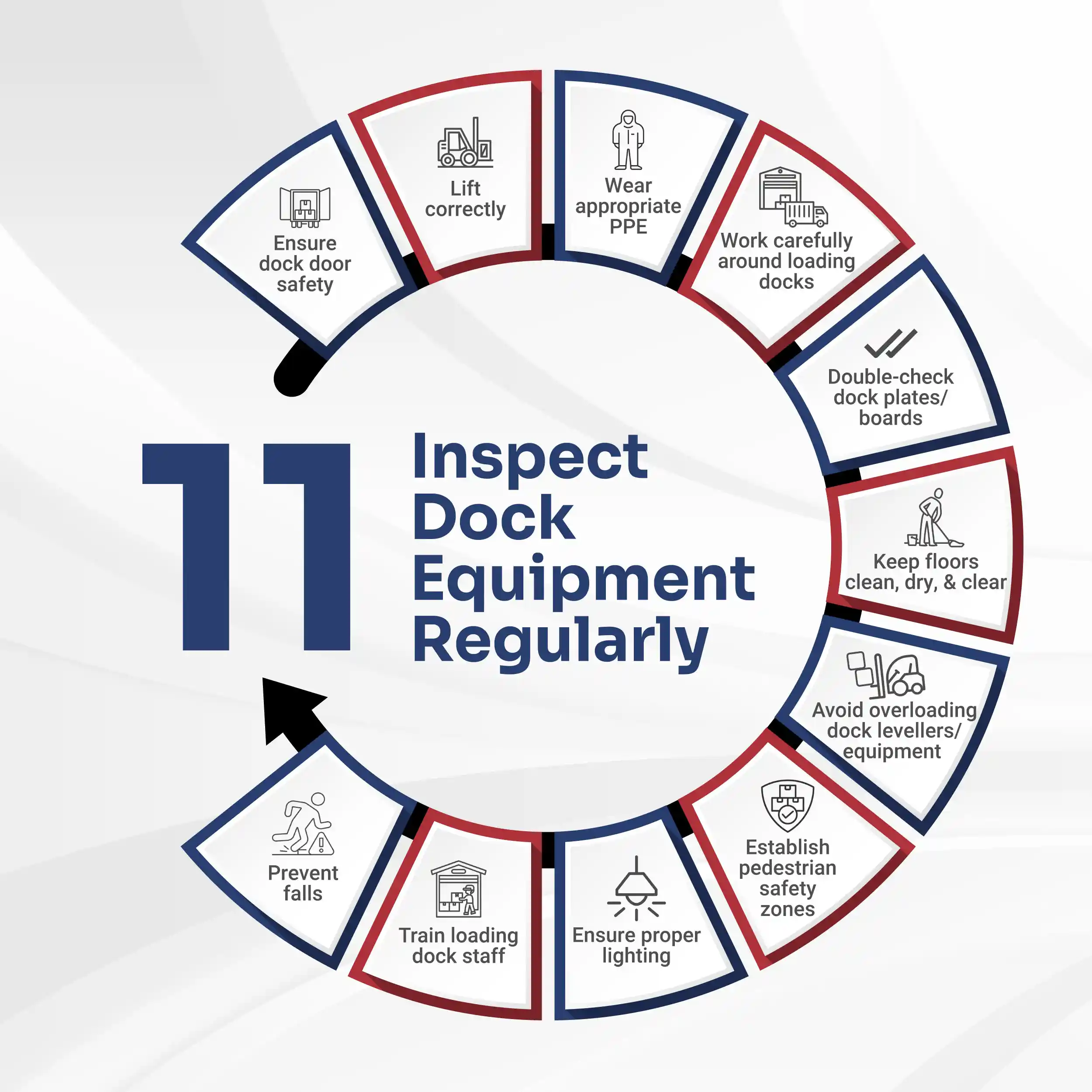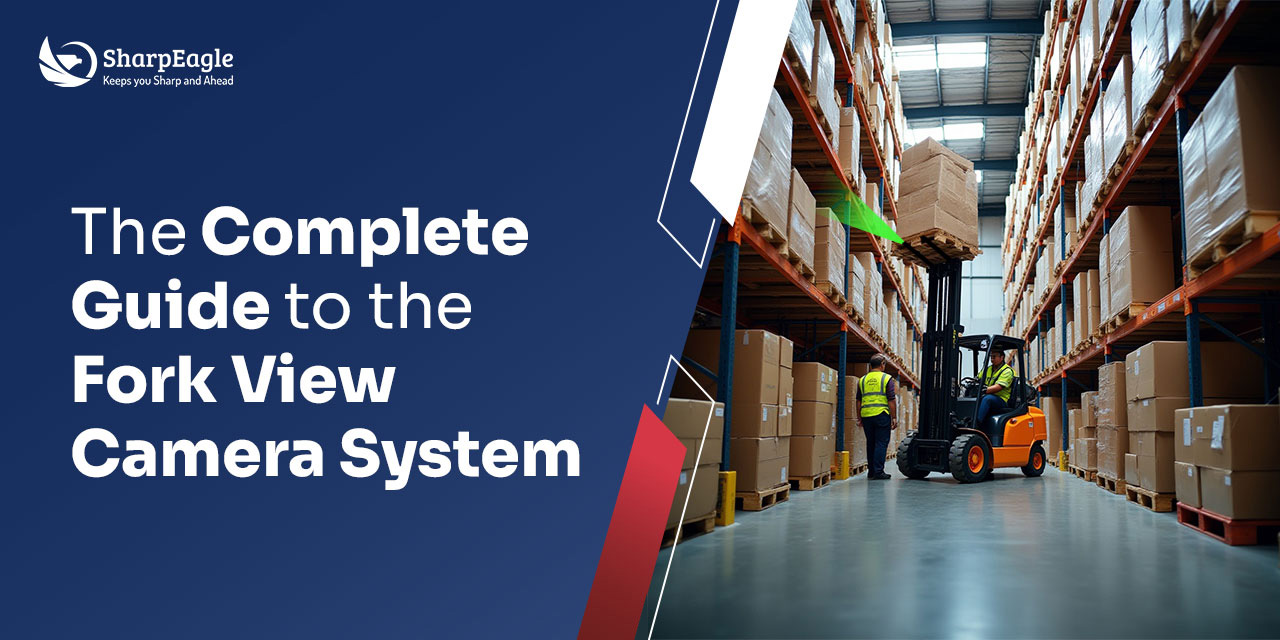

تمثل أرصفة التحميل تحديات خطيرة تتعلق بالسلامة يجب على مديري المستودعات معالجتها يوميًا. وقد ارتبطت هذه المنصات الخرسانية حيث تلتقي الشاحنات بالمباني بحوالي 100 حالة وفاة سنويًا في السنوات الأخيرة، مع إصابة 35000 عامل آخر بجروح خطيرة.
كان من الممكن منع معظم هذه الحوادث من خلال تدابير السلامة المناسبة. لا تتعلق Warehouse Dock Safety بوضع علامة على المربعات أو تجنب عمليات التفتيش. يتعلق الأمر بعودة العمال إلى منازلهم سليمين كل ليلة.
وفقًا لـ OSHA (إدارة السلامة والصحة المهنية)، 25% من جميع حوادث المستودعات يحدث في رصيف التحميل. تمثل منطقة التحميل المنطقة الأكثر فتكًا في أي مركز توزيع، حيث تشغل المركبات التي يبلغ وزنها 40 طنًا والرافعات الشوكية المسرعة والمشاة نفس المساحة الضيقة.
أرصفة التحميل عبارة عن منصات خرسانية عادة ما تكون أربعة أقدام فوق مستوى سطح الأرض حيث يتم نقل البضائع بين الشاحنات والمستودعات. فكر فيها على أنها عتبات ذات حجم صناعي مع حواجز مميتة من ثلاث جهات.
على الرغم من أهميتها، إلا أنها تجلب أيضًا العديد من المخاطر، بما في ذلك:
وفقًا لمدير الصحة والسلامة (HSE)، تتسبب الزلات والرحلات والسقوط في أخطر الإصابات في العمل. إنهم يشكلون أكثر من ثلث جميع الإصابات المبلغ عنها.

يتطلب القانون الحكومي تدابير سلامة محددة في كل رصيف تحميل في جميع أنحاء المملكة المتحدة.
.webp)
تتطلب تحسينات السلامة الحقيقية أكثر من الملصقات التحفيزية واجتماعات السلامة.
أحدثت تقنية الكاميرا ثورة في سلامة المعدات في العقد الماضي.
1. القضاء على النقاط العمياء باستخدام كاميرات 360 درجة: تعمل كاميرات CCTV بزاوية 360 درجة المثبتة على الرافعات الشوكية على التخلص من النقاط العمياء التي لا يمكن للمرايا تغطيتها. تعرض الكاميرات الخلفية المشاة والعقبات أثناء عمليات الدعم. تكتشف الكاميرات الجانبية العمال الذين يقتربون من أي اتجاه قبل حدوث التصادمات. تراقب الكاميرات العلوية استقرار التحميل وتمنع حوادث الانقلاب أثناء عمليات التكديس.
توفر زوايا الكاميرا المتعددة المعروضة على شاشات لوحة القيادة للمشغلين وعيًا كاملاً بمحيطهم. أنظمة كاميرات الرؤية بزاوية 360 درجة تكلف أقل من دعوى قضائية واحدة تتعلق بالإصابة الخطيرة وتمنع الحوادث التي لا تستطيع المرايا اكتشافها.
2. المراقبة في الوقت الفعلي باستخدام الأنظمة التي تعمل بالذكاء الاصطناعي: تميز تطبيقات الذكاء الاصطناعي المدمجة في أنظمة الكاميرا بين الأشياء الثابتة والأشخاص المتحركين. تحذر التنبيهات الذكية المشغلين عندما يدخل العمال مناطق الخطر حول المعدات. ترصد مراقبة الحمولة نقل البضائع قبل أن تصبح الأحمال غير مستقرة وتسقط.
يوفر تسجيل الفيديو أدلة على التحقيقات في الحوادث والمواد التدريبية التي تعرض المخاطر الحقيقية في مكان العمل. تحدد مراجعة اللقطات الحوادث الوشيكة التي تفوتها أنظمة الإبلاغ التقليدية تمامًا.
3. أجهزة استشعار القرب وأنظمة الرادار: يجمع تكامل الرادار والمستشعر بين أنظمة الكاميرا والكشف بالموجات فوق الصوتية والرادار لتحديد العوائق بشكل كامل. يتم تشغيل الكبح التلقائي عندما تكتشف أجهزة الاستشعار الاصطدامات الوشيكة مع الأشخاص أو الأشياء. يعمل الرادار في ظروف مليئة بالغبار حيث قد تكون الكاميرات مشوشة.
تتكامل حلول سلامة المستودعات هذه مع المعدات الموجودة وتوفر تحسينات فورية للسلامة دون تعديلات كبيرة على المرافق.
يكلف Warehouse Dock Safety المال مقدمًا، ولكنه ينقذ الأرواح ويمنع الدعاوى القضائية. حديث نصائح لسلامة رصيف التحميل ركز على منع الحوادث قبل حدوثها بدلاً من الاستجابة بعد إصابة العمال.
حلول سلامة المستودعات المتقدمة، بما في ذلك كاميرات CCTV بزاوية 360 درجة وأضواء سلامة رصيف التحميل، تدفع تكاليفها من خلال أقساط التأمين المخفضة وتجنب تكاليف الحوادث. توفر لوائح OSHA الحد الأدنى من المعايير، لكن المشغلين الأذكياء يتجاوزون المتطلبات لحماية العمال والشركات.
ستواجه الشركات التي لا تزال تعمل بمعايير السلامة في التسعينيات في نهاية المطاف مآسي يمكن الوقاية منها تدمر العائلات والشركات المفلسة. تجعل التكنولوجيا الحالية السلامة الشاملة للرصيف ميسورة التكلفة لأي عملية جادة في حماية العمال بدلاً من مجرد تجنب الغرامات.
لا تنتظر وقوع حادث. اختر SharpeEagle للحصول على أدوات أمان آمنة وذكية وبأسعار معقولة. نحن نساعد في الحفاظ على سلامة العاملين لديك ونوفر لك المال. اتصل بـ شارب إيجل اليوم.
تعرف على المزيد حول سلامة رصيف التحميل من خلال هذه الأسئلة الشائعة:
1. ما أنواع الحوادث التي تحدث في أرصفة التحميل؟
في أرصفة التحميل، يمكن أن يصطدم العمال بالرافعات الشوكية، أو يسقطون من حافة الرصيف، أو يتعرضون للسحق عندما تتحرك المقطورات في وقت مبكر جدًا. يعد الانزلاق أو التعثر على الأرضيات المبللة أمرًا شائعًا أيضًا. تجعل هذه الحوادث Warehouse Dock Safety مهمة جدًا للحفاظ على سلامة الأشخاص وتجنب الإصابات الخطيرة.
2. كيف يمكن تحسين سلامة رصيف التحميل؟
لجعل أرصفة التحميل أكثر أمانًا، يحتاج العمال إلى التدريب المناسب والعلامات الواضحة. تساعد مصابيح أمان Loading Dock الأشخاص على الرؤية بوضوح. تعمل الكاميرات وأجهزة الاستشعار الموجودة على الرافعات الشوكية على إيقاف حوادث النقاط العمياء. يساعد أيضًا استخدام أقفال المقطورة ودرابزين الحماية. حلول سلامة المستودعات هذه تجعل المنطقة أكثر أمانًا لكل من يعمل هناك.
3. ما هو معيار OSHA لسلامة الرصيف؟
تنص لوائح OSHA على أن الأرصفة يجب أن تحتوي على قضبان أمان ورافعات شوكية عاملة وعمال مدربين. يجب فحص أدوات Dock كثيرًا. يجب وضع علامات على المواد الكيميائية الخطرة. توجد قواعد السلامة لإيقاف الحوادث. اتباع لوائح OSHA يعني أن المستودعات يجب أن تحافظ على أرصفة التحميل آمنة لجميع الموظفين.
4. ما هي مخاطر رصيف التحميل الأكثر شيوعًا؟
تشمل المخاطر الشائعة حوادث الرافعة الشوكية والسقوط من الأماكن المرتفعة والانزلاق. المقطورات غير المقفلة محفوفة بالمخاطر أيضًا. هذه الأشياء يمكن أن تؤذي العمال بشدة. يساعد اتباع نصائح سلامة رصيف التحميل واستخدام الأدوات المناسبة في إيقاف هذه المشكلات والحفاظ على مناطق رصيف التحميل أكثر أمانًا للجميع في المستودع.
5. لماذا تعتبر سلامة رصيف التحميل في المستودعات مهمة جدًا؟
تعتبر سلامة Warehouse Dock مهمة لأن الأرصفة مشغولة ومحفوفة بالمخاطر. بدون أمان، يمكن أن يتأذى الناس أو حتى يموتوا. الأرصفة الآمنة تعني عددًا أقل من الحوادث وعدم التأخير. يساعد استخدام حلول سلامة المستودعات والأضواء والكاميرات على حماية العمال والحفاظ على استمرار الأعمال التجارية دون مشاكل كبيرة أو دعاوى قضائية.
6. ما هي بعض أفضل الممارسات المهمة لسلامة الرصيف؟
أبقِ الرافعات الشوكية بعيدًا عن الأشخاص، واستخدم ملابس مشرقة، وأصلح الأدوات عند كسرها. أضف أضواء السلامة والكاميرات في رصيف التحميل لإيقاف الحوادث. استخدم أقفال المقطورة والحواجز. تساعد نصائح سلامة رصيف التحميل السهلة هذه على منع الإصابات وجعل المستودعات أماكن أكثر أمانًا للعمل كل يوم.



